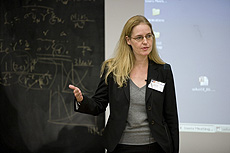U.S. LHC Users' meeting focuses on future

Jean Cottam, assistant director for Physical Sciences and Engineering in the Office of Science and Technology Policy, speaks at the U.S. LHC Users' meeting on Oct. 24.
While technology has made communication easier, last month's U.S. LHC Users' meeting was the first time that all U.S. LHC communities had come together.
The meeting, which brought together accelerator research, ALICE, ATLAS, CMS, LHCb and TOTEM communities, was an opportunity for status updates about the LHC and its experiments, updates from the CERN Users organization and a chance to focus on the future of the machine.
Scientists at the meeting discussed a plan for the LHC, the machine's schedule and the LHC Accelerator Research Program. They heard from Alan Boyle, MSNBC science writer, who spoke on his perception of the LHC in popular culture.
Jean Cottam, assistant director for Physical Sciences and Engineering, talked about the future of the field and the role that the Office of Science and Technology plays in advising the President and the Office of Management and Budget.
Cottam, a NASA astrophysicist, said she admires the fixability of LHC scientists' current problems.
"When we build experiments, we launch them into space. If something goes wrong, it is all over. We have no chance to fix them," she said. "You have an unfortunate situation on your hands, but a delay is just a delay."
She encouraged laboratory employees and users to keep OSTP informed of issues, challenges and valuable projects.
"What you're doing is exciting and important," Cottam said.
-- Rhianna Wisniewski
|